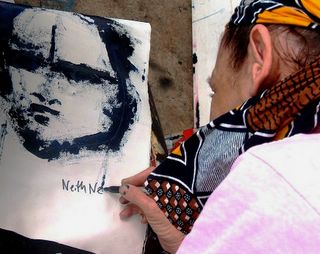
by Jorge Reyes
Neith Nevelson, an American artist, was born in New York City in 1946. Her grandmother was Louise Nevelson, the Russian-born American artist who became famous for her unusual sculptures often made from recycled material.
As has been pointed out, Neith paints visions from the imagination, exploring the figurative, symbolic and narrative. She believes that art has the power to connect, to transport, to make people feel. She is intolerant of art that merely amuses, art as a concept or process, and any art that merely amuses or that does not attempt to touch the viewer through the intellect.
 While the art world of the last quarter century has experienced a pluralism of styles, Neith Nevelson has stubbornly pursued her personal iconography, one that can safely be called ‘Neithicism’. Abandoning the ambivalence and incongruity of contemporary art’s fragmented shifting styles Neith Nevelson’s works are also refreshingly original. In fact, her art is so rudimentary, that art critics have had a hard time accepting Neith as a serious artist; both a shame and a tragedy. It must not be forgotten that when Louise Nevelson was experimenting with her sculptures, art critics dismissed them as "junk". Louise persisted, nonetheless, and for the next 30 years she created her unique form of abstract art which is so coveted and respected these days.
While the art world of the last quarter century has experienced a pluralism of styles, Neith Nevelson has stubbornly pursued her personal iconography, one that can safely be called ‘Neithicism’. Abandoning the ambivalence and incongruity of contemporary art’s fragmented shifting styles Neith Nevelson’s works are also refreshingly original. In fact, her art is so rudimentary, that art critics have had a hard time accepting Neith as a serious artist; both a shame and a tragedy. It must not be forgotten that when Louise Nevelson was experimenting with her sculptures, art critics dismissed them as "junk". Louise persisted, nonetheless, and for the next 30 years she created her unique form of abstract art which is so coveted and respected these days. Despite much that has been misunderstood about Neith’s art (including much that has been written about her personal life), what can safely be said is that throughout a long and prolific career, she has finally become comfortable as an artist and narrowed her artistic interests to three main categories to which she invariably returns again and again: horses, naked women and faces. In turn, each of these seem to symbolize some common denominator, such as: from chaos peace, from life death, and so on. Surprisingly, the artist herself simply stands back and says nothing about her own life, about her own philosophy, nor what she seeks to interpret.

Picture @2005 Becarley Stout
Horses, Women and Faces
All three categories of Neith’s painting— horses, women and faces— fill the canvas with a controlled spontaneity found in the great masters.
 Some critics have pointed out that Neith’s horses stand out above the rest of all her works. Ironically, horses are Neith’s simplest works: just simple intertwining lines and loops, nothing more. Yet, these are her most perfectly-rendered as far as form and shape; and, the larger the canvas the more striking these images become. Paired in groups or by themselves, these horses are playful, coy, grazing by themselves. This is a time to relax, to contemplate, to be in communion with nature. Even in quarrelsome playfulness, this is the world of childhood innocence, something hoped-for, rarely experienced in adulthood.
Some critics have pointed out that Neith’s horses stand out above the rest of all her works. Ironically, horses are Neith’s simplest works: just simple intertwining lines and loops, nothing more. Yet, these are her most perfectly-rendered as far as form and shape; and, the larger the canvas the more striking these images become. Paired in groups or by themselves, these horses are playful, coy, grazing by themselves. This is a time to relax, to contemplate, to be in communion with nature. Even in quarrelsome playfulness, this is the world of childhood innocence, something hoped-for, rarely experienced in adulthood. 
Neith’s naked women are amorphous, seeming to be refractions and not actual representations of women. Sea-like, these women are in a state of cleansing, metaphysical or otherwise. Some of these women are even portrayed with large gaps in their bodies. These gaps don’t seem to be representative of physical pain but rather emblematic of some sort of essential deficiency. Why does it have to be this way is a question that is never answered.
The women say nothing themselves, of course, they don't trust us, the viewer. Our voyeurism seems to be part of the game, but their intimacy is never part of ours.
 Neith’s faces, like her naked women, also have a rudimentary lack of proportion. Invariably they seem to have strong, Afro-centric features. At first, these faces seem threatening and accusatory. On closer look, though, we notice that these hardened, squinting-seeming faces are delicate, frail almost, only toughened and hardened by a careless existence. Neith has called these faces her "nebulas."
Neith’s faces, like her naked women, also have a rudimentary lack of proportion. Invariably they seem to have strong, Afro-centric features. At first, these faces seem threatening and accusatory. On closer look, though, we notice that these hardened, squinting-seeming faces are delicate, frail almost, only toughened and hardened by a careless existence. Neith has called these faces her "nebulas." 
Painting passionately and with the singular vision to succeed, Neith Nevelson has developed a truly distinctive style. Her art is often simple, often chaotic, though never simplistic. What has developed to this day is a wholy personal style.
In the meantime, everyday, before dawn, in those few, quiet hours before the beginning of a hectic day, Neith Nevelson can be found painting, by herself, next to her ever faithful dog Magga.


